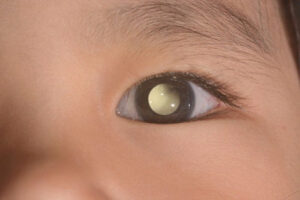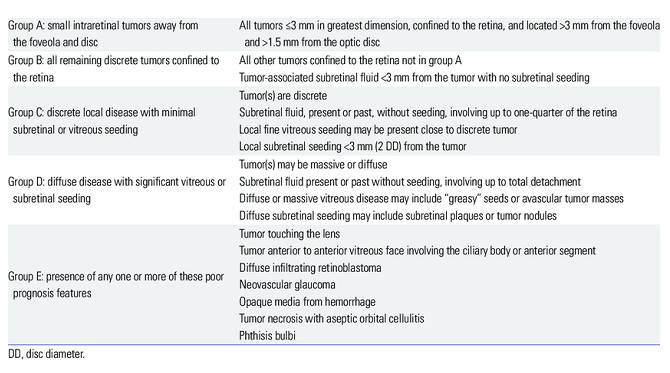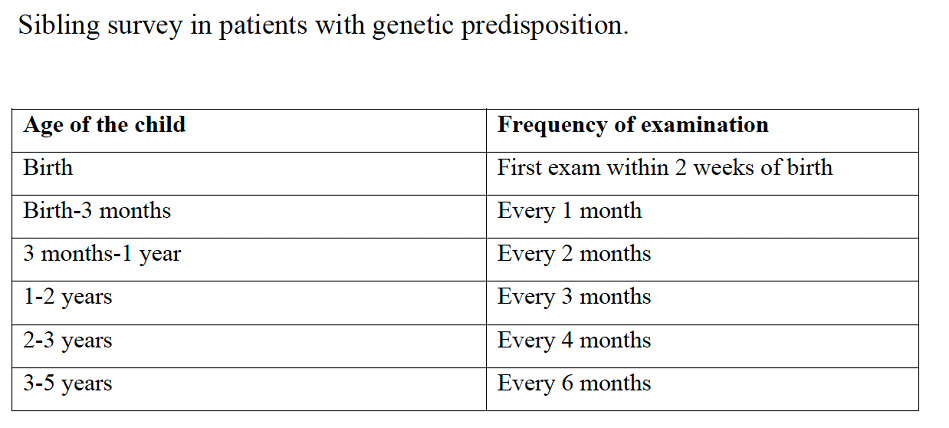CASE DETAILS
A 15 months old female child was brought with c/o whitish pupillary reflex in the left eye (RE), for the past 2 months. No redness, swelling or pain was noted. The mother had noticed the white reflex for the past 2 months, but has disregarded as vitamin deficiency. The child was 1st born to non consanguineous parents, through normal vaginal delivery and the antenatal period was uneventful. She was developmentally normal for age. No significant family history was noted.
The child was taken to an ophthalmologist and Indirect ophthalmoscopy showed a whitish mass in left eye and right eye was normal. USG B scan showed a dome-shaped echogenic mass arising from the retina extending into the vitreous cavity. Hence she was referred here for further evaluation. Here, MRI Orbit and brain was done which was suggestive of left eye Retinoblastoma (Group D) without extension to the brain. The parents have been counseled regarding the disease and planned for intravenous chemotherapy and local therapy.
DISCUSSION
Retinoblastoma represents 3% of all childhood cancers, and is the most common intraocular malignancy of childhood. India peaks with incidence of >1400 cases of 8000 cases of RB in the world. But, there is a vast difference in mortality between the developed and developing countries (1). This difference is mainly due to delay in diagnosis in developing countries (2). Delay in diagnosis and treatment of RB affects the vision, globe and life salvage.
It occurs as a result of mutation of RB1 gene at chromosome 13q14. It is inherited as an autosomal dominant fashion with the penetrance of 95%. According to the Knudson’s “two-hit” model, two events are necessary for the retinal cell or cells to develop into tumors. The first mutational event can be inherited (germline or constitutional) and the second “hit” results in the loss of the remaining normal allele and occurs within a particular retinal cell. In the sporadic, non-heritable form of retinoblastoma, both mutational events occur within a single retinal cell after fertilization (somatic events), resulting in unilateral retinoblastoma.
The most common presenting symptom is White eye reflex, also known as leukocoria (Fig 1), followed by strabismus. The diagnosis of retinoblastoma is based on examination by an ophthalmologist and imaging studies. A biopsy is rarely indicated. The Grouping and staging is done by intraocular staging of Retinoblastoma (ICRB) staging. Treatment of retinoblastoma
involves a multidisciplinary approach involving an ophthalmologist, pediatric oncologist, pediatric radiation oncologists and genetic counselors (3).

Fig 1 : White Reflex (Leukocoria) ,

Fig 2: ICRB staging of Retinoblastoma
The treatment involves a combination of (4),
- Intravenous Chemotherapy
- Local therapy
- Intra-arterial chemotherapy (IAC),
- Intravitreal chemotherapy (IVitC)
- Cryotherapy
- Laser Thermotherapy
- Radiotherapy – external beam (EBRT) or brachytherapy
- Enucleation
Enucleation is recommended only when there is no chance for useful vision, and there is a high risk for metastatic and extra ocular spread . The enucleated sample should be examined for high risk features.
SIBILING SCREENING
This is crucial in familial retinoblastoma for children < 5 years of age. With careful clinical screening alone, 50% cases can be diagnosed by 2 months of age, 85% by 6 months, and nearly 100 % by 12 months.
CONCLUSION
Early diagnosis and treatment improves the visual outcome. Red eye reflex should be done for all children less than 5 years during routine immunization visits.
“Look into their eyes so that they can see the world”
REFERENCES
Bhakta N, Force LM, Allemani C. et al. Childhood cancer burden: a review of global estimates. Lancet Oncol 2019; 20 (01) e42-e53
Arul J, Ganesan S, Khetan V, Sneha LM, Jayaraman D, Scott JX. Challenges in the management of retinoblastoma during nationwide locked down: an experience from retinoblastoma centre in south India: Ind J Med Paediatr Oncol 2022;43:250–254
Ancona-Lezama D, Dalvin LA, Shields CL. Modern treatment of retinoblastoma: A 2020 review. Indian J Ophthalmol. 2020 Nov;68(11):2356-2365. doi: 10.4103/ijo.IJO_721_20. PMID: 33120616; PMCID: PMC7774148.
Shields CL, Jorge R, Say EAT, Magrath G, Alset A, Caywood E, et al. Unilateral retinoblastoma managed with intravenous chemotherapy versus intra-arterial chemotherapy. Outcomes based on the international classification of retinoblastoma. Asia-Pacific J Ophthalmol (Phila) 2016;5:97-103.
 Dr. Janani Arul
Dr. Janani Arul
Consultant Paediatric Haemato Oncology
Kauvery Hospital Chennai
